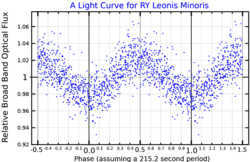G117-B15A[7] is a small, well-observed variable white dwarf star of the DAV, or ZZ Ceti, type in the constellation of Leo Minor.
| Observation data Epoch J2000.0 Equinox J2000.0 (ICRS) | |
|---|---|
| Constellation | Leo Minor |
| Right ascension | 09h 24m 15.25s[2] |
| Declination | +35° 16′ 51.4″[2] |
| Apparent magnitude (V) | 15.5[3] |
| Characteristics | |
| Spectral type | DAV4[3] |
| U−B color index | −0.6[3] |
| B−V color index | +0.2[3] |
| Variable type | DAV[3] |
| Astrometry | |
| Proper motion (μ) | RA: −145.181[2] mas/yr Dec.: −0.053[2] mas/yr |
| Parallax (π) | 17.3947 ± 0.0452 mas[2] |
| Distance | 187.5 ± 0.5 ly (57.5 ± 0.1 pc) |
| Absolute magnitude (MV) | 11.79[4] |
| Details | |
| Mass | 0.69[4] M☉ |
| Surface gravity (log g) | 8.14[4] cgs |
| Temperature | 12,400[5] K |
| Other designations | |
| Database references | |
| SIMBAD | data |
G117-B15A was found to be variable in 1974 by Richer and Ulrych,[8] and this was confirmed in 1976 by McGraw and Robinson.[9] In 1984 it was demonstrated that the star's variability is due to nonradial gravity wave pulsations. As a consequence, its timescale for period change is directly proportional to its cooling timescale, allowing its cooling rate to be measured using astroseismological techniques.[7] Its age is estimated at 400 million years.[10] Its light curve has a dominant period of 215.2 seconds,[7] which is estimated to increase by approximately one second each 14 million years.[11] G117-B15A has been claimed to be the most stable optical clock ever found, much more stable than the ticks of an atomic clock.[12] It is also the first pulsating white dwarf to have its main pulsation mode index identified.[7]
An X-ray source in the constellation Leo Minor is the white dwarf G117-B15A.[13]
Notes
edit- ^ Chote, P.; Sullivan, D. J.; Brown, R.; Harrold, S. T.; Winget, D. E.; Chandler, D. W. (May 2014). "Puoko-nui: a flexible high-speed photometric system". Monthly Notices of the Royal Astronomical Society. 440 (2): 1490–1497. arXiv:1412.5724. doi:10.1093/mnras/stu348.
- ^ a b c d e Vallenari, A.; et al. (Gaia collaboration) (2023). "Gaia Data Release 3. Summary of the content and survey properties". Astronomy and Astrophysics. 674: A1. arXiv:2208.00211. Bibcode:2023A&A...674A...1G. doi:10.1051/0004-6361/202243940. S2CID 244398875. Gaia DR3 record for this source at VizieR.
- ^ a b c d e McCook, George P.; Sion, Edward M. (March 1999). "A Catalog of Spectroscopically Identified White Dwarfs". Astrophysical Journal Supplement. 121 (1): 1–130. Bibcode:1999ApJS..121....1M. doi:10.1086/313186. S2CID 122286998. CDS ID III/210.
- ^ a b c Gianninas, A.; Bergeron, P.; Ruiz, M. T. (2011). "A Spectroscopic Survey and Analysis of Bright, Hydrogen-rich White Dwarfs". The Astrophysical Journal. 743 (2): 138. arXiv:1109.3171. Bibcode:2011ApJ...743..138G. doi:10.1088/0004-637X/743/2/138. S2CID 119210906.
- ^ Kepler, S. O.; Winget, D. E.; Vanderbosch, Zachary P.; Castanheira, Barbara Garcia; Hermes, J. J.; Bell, Keaton J.; Mullally, Fergal; Romero, Alejandra D.; Montgomery, M. H.; Degennaro, Steven; Winget, Karen I.; Chandler, Dean; Jeffery, Elizabeth J.; Fritzen, Jamile K.; Williams, Kurtis A.; Chote, Paul; Zola, Staszek (2020). "The Pulsating White Dwarf G117-B15A: Still the Most Stable Optical Clock Known". The Astrophysical Journal. 906 (1): 7. arXiv:2010.16062. Bibcode:2021ApJ...906....7K. doi:10.3847/1538-4357/abc626. S2CID 226222216.
- ^ "V* RY LMi". SIMBAD. Centre de données astronomiques de Strasbourg. Retrieved 2023-01-30.
- ^ a b c d Kepler, S. O.; et al. (2000-05-10). "Evolutionary Timescale of the Pulsating White Dwarf G117-B15A: The Most Stable Optical Clock Known". The Astrophysical Journal Letters. 534 (2): L185–L188. arXiv:astro-ph/0003478. Bibcode:2000ApJ...534L.185K. doi:10.1086/312664. PMID 10813678. S2CID 14540467.
- ^ High-frequency optical variables. II. Luminosity-variable white dwarfs and maximum entropy spectral analysis, H. B. Richer and T. J. Ulrych, Astrophysical Journal 192 (September 1974), pp. 719–730.
- ^ High-speed photometry of luminosity-variable DA dwarfs: R808, GD 99, and G 117-B15A, J. T. McGraw and E. L. Robinson, Astrophysical Journal 205 (May 1976), pp. L155–L158.
- ^ Pivetta, Marcos (January 2006). "The star of the moment". Retrieved 2007-06-06.
- ^ From Ṗ=2.3·10−15 in Kepler et al.
- ^ McDonald Observatory. "Astronomers Find Most Stable Optical Clock in Heavens; Aids Understanding of Stars' Lives". McDonald Observatory. Retrieved 2007-06-06.[permanent dead link]
- ^ Kepler SO (December 5, 2005). "Astronomers Find Most Stable Optical Clock In Heavens".
